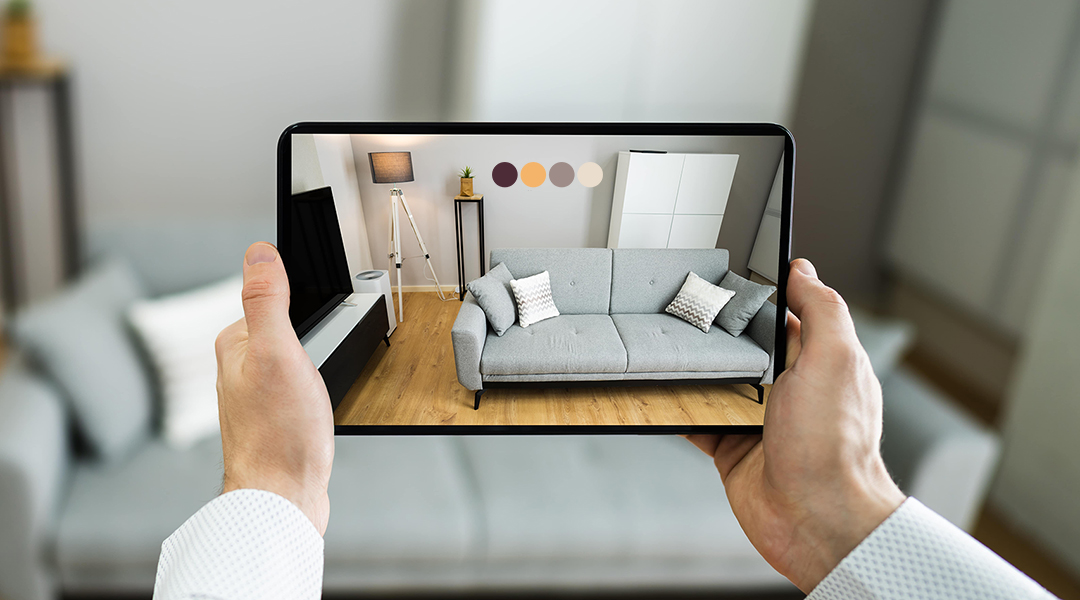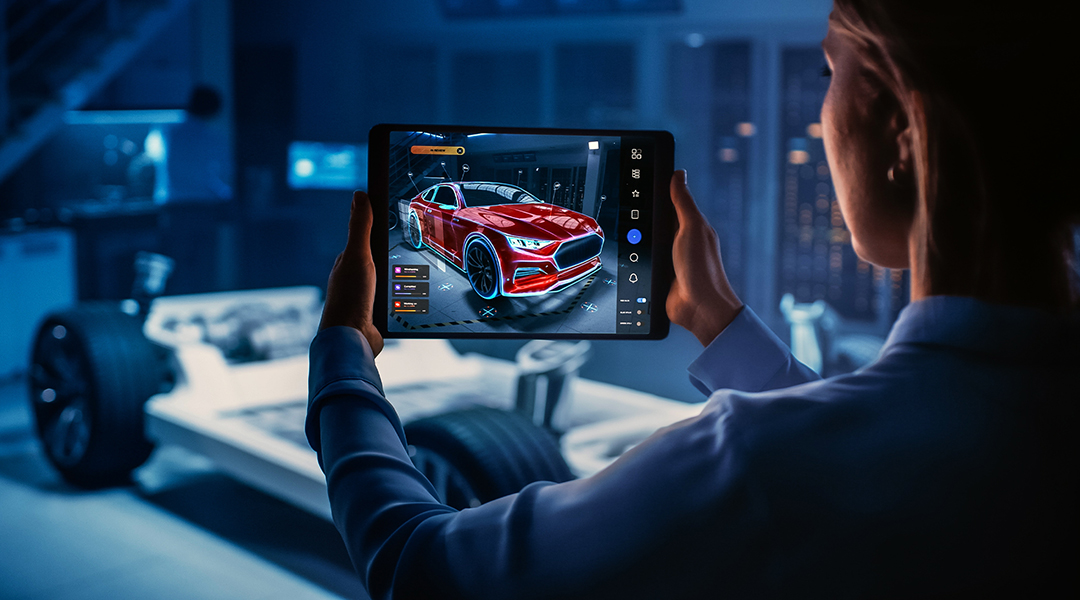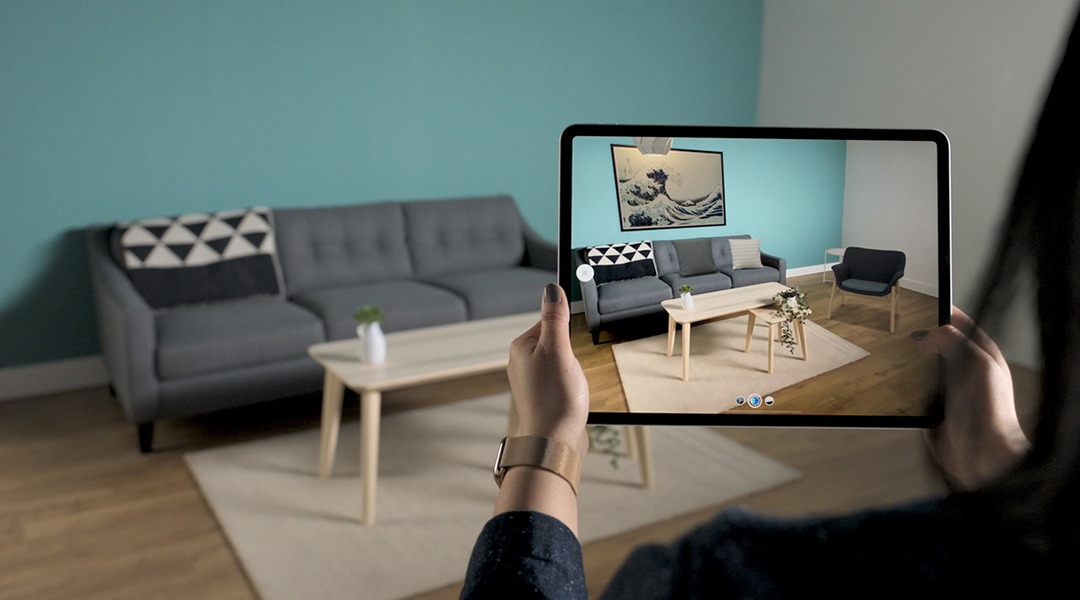People thinking about getting a new car usually check out different manufacturers' websites. But it's tough to really get a feel for a car just from pictures and a list of features. That's where car configurators come into play. These nifty tools are game-changers for showing off what a car is all about in a more interactive way.
Nowadays, it's pretty common to stumble upon these configurators on just about every major car brand's site, and they're definitely doing their job. Adobe even did a study and found out that these kinds of customization tools, like car configurators, are behind more than 50% of sales conversions.
So, what's the big deal with a car configurator, and why should companies think about getting their own custom configurator development done? A 3D car configurator is this cool interactive feature that lets you mess around with the car's look, from the paint job to the rims and even the interior, all in 3D. The best 3D car configurator out there can make it feel like you're right there with the car, making all these custom tweaks.
And when companies invest in creating their own unique configurator, they're not just making shopping more fun; they're also making it easier for buyers to decide, boosting those conversion rates and really letting the car's best features shine. This piece is all about diving into why car configurators, especially the 3D ones, are becoming a must-have for car sellers.
Car Configurator Meaning Explained
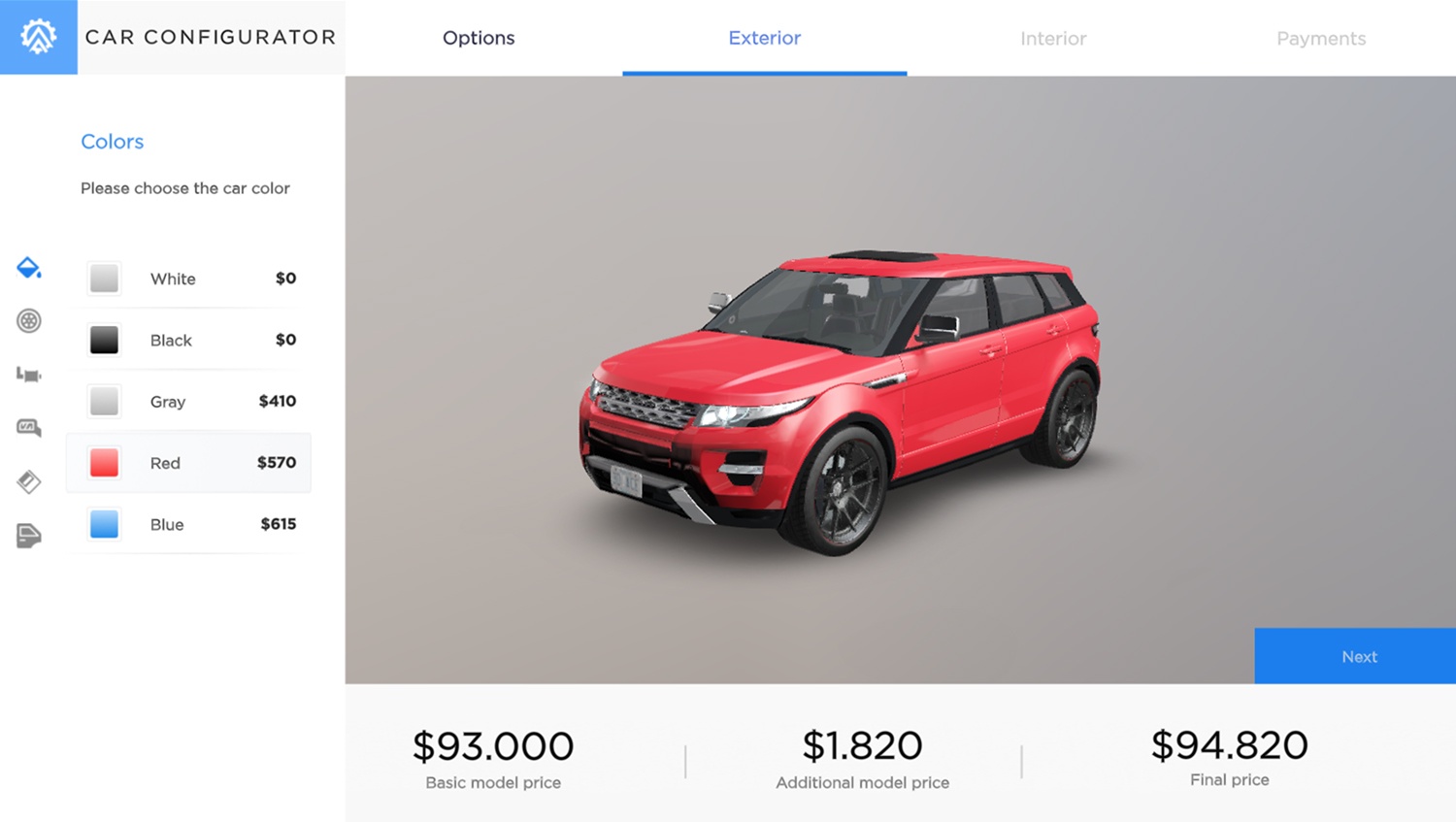
A car configurator is a sophisticated digital tool designed to allow users to personalize numerous features and components of a vehicle to their liking. The user interface is typically dominated by a vivid visualization of the vehicle, surrounded by an array of menus and options for customization.
As users make selections and adjustments within these menus, the changes are reflected instantaneously in the vehicle's visual representation. Moreover, this dynamic tool can display and update supplementary details such as the vehicle's price and performance metrics, offering a comprehensive overview of the customizations' impact.
Contrary to the assumption that such a tool is exclusively beneficial to car manufacturers, many businesses within the automotive sector and beyond find immense value in utilizing car configurators. For instance, automotive repair and enhancement services employ these configurators to demonstrate potential upgrades and modifications, allowing customers to visualize the enhancements their vehicles might undergo.

Similarly, gaming has embraced this technology, incorporating car configurators into racing games to enrich the gaming experience. Players are allowed to design and modify their vehicles, tailoring them to their preferences as they progress through the game. Titles like Need for Speed offer these engaging customization features, enabling players to immerse themselves fully in the automotive aspect of gaming.
The best 3D car configurator transcends mere functionality, offering an immersive experience that allows users to engage with a 3D car model in real time. This level of interaction is not just about selecting colors or wheel designs; it's about experiencing the car in a virtual space and making informed decisions through an engaging and informative process.
The 3D car configurator has become an indispensable tool, not only for those directly selling cars but also for a broader audience, including service providers and game developers seeking a more interactive and personalized experience. By integrating a 3D car configurator into their platforms, businesses can significantly enhance customer engagement, providing a tactile sense of ownership and personal connection to the vehicle long before any physical interaction.
What Are the Benefits of Using a Car Configurator?
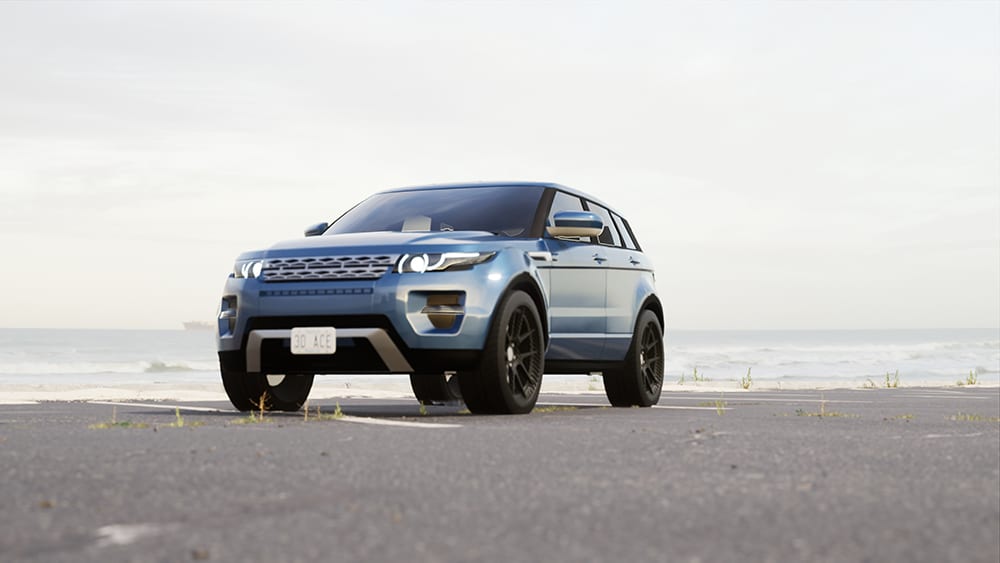
Car configurator developed by Program-Ace
A car configurator offers a digital platform that enables users to personalize various elements and components of a vehicle, enhancing their engagement and comprehension of the product. The interface typically features a prominent visualization of the vehicle, surrounded by multiple menus, allowing extensive customization options.
As users select different options, the visual representation of the car updates in real-time, providing immediate feedback on their choices. Additionally, this interactive tool can display and dynamically update supplementary details like pricing and performance metrics, further aiding users in making informed decisions.
The utility of a car configurator extends far beyond its application by automobile manufacturers. Various businesses within the automotive industry, including repair services, leverage configurators to illustrate potential enhancements and visualize modifications for their clients. Similarly, the gaming industry incorporates these tools within racing titles, enabling players to design and evolve their vehicles. Titles such as Need for Speed are renowned for offering deep customization features, allowing players to tailor their cars to their preferences, thereby enhancing the gaming experience.
From a business perspective, the advantages of implementing a car configurator are manifold and significant. For one, it serves as a powerful marketing tool, engaging potential buyers by allowing them to interact with a 3D representation of their desired car. This interactivity not only boosts user engagement but also facilitates a deeper connection between the customer and the product. Furthermore, a well-designed car configurator can streamline the sales process, enabling customers to explore various options and make decisions more confidently, leading to increased conversion rates.
The best 3D car configurator goes a step further by offering an immersive experience that closely mimics the real-life process of customizing a vehicle. Additional context on configuration models is provided in types of product configurators. By providing a realistic 3D model of the car, these configurators allow users to explore every angle and customize features with unparalleled precision. The result is a highly personalized and engaging experience that can significantly enhance customer satisfaction and loyalty.
As a result, the strategic application of a car configurator can provide substantial benefits to businesses within the automotive sector and beyond. By offering an intuitive, engaging, and informative platform for vehicle customization, companies can improve customer engagement, streamline the purchasing process, and ultimately drive sales. Still, the benefits gained by businesses applying it are both more numerous and noteworthy. Below are the main ones:
Better presentation of your product
Upgrading user interaction remains a paramount objective for businesses focused on products and services, achieving a palpable excitement surrounding their offerings is deemed a considerable triumph. The allure of car configurator software lies in its engaging nature and its ability to tap into our creative instincts, prompting us to experiment with a myriad of distinct combinations until we discover the one that not only looks but also performs optimally. Such a dynamic level of engagement is unattainable through mere photo visuals and descriptive text.
The interactive experience provided by a car configurator is unparalleled, offering a hands-on approach to customization that captivates users. With the integration of a 3D car configurator, the experience is further enhanced, allowing for a more immersive exploration of the car's potential. Users can modify everything from the exterior paint color to the wheel design and interior finishes, seeing their choices come to life in real-time 3D visualization. The best 3D car configurator amplifies this experience, rendering detailed textures and lighting effects that make the virtual car appear almost tangible.
For businesses, the deployment of a car configurator on their digital platforms can significantly amplify user engagement rates. When customers interact with a 3D car, adjusting and personalizing it to their liking, they form a deeper connection with the product. This not only aids in better understanding the car's features and capabilities but also fosters a sense of ownership and personal attachment, making the car configurator an invaluable tool in the digital marketing arsenal of the automotive industry.
Increased conversion rate
Beyond the enjoyment derived from experimenting with various design and performance enhancements, a configurator tool offers tangible benefits by aiding users in making informed purchasing decisions. Through the interactive capabilities of a car configurator, users gain the opportunity to view the vehicle from multiple perspectives, acquainting themselves with the myriad of available upgrades, model variations, and color options. The frustration that consumers often face due to the lack of detailed information and visual previews from some companies is effectively addressed by the implementation of a 3D car configurator.
Such an advanced tool elevates the shopping experience by providing an immersive, engaging platform where every adjustment and customization is reflected in a real-time 3D model of the car. The best 3D car configurator goes a step further by offering an exceptionally lifelike representation of the car, complete with accurate depictions of interior and exterior features, textures, and how different lighting conditions affect the vehicle's appearance.
Consequently, the adoption of a car configurator by automotive retailers and manufacturers significantly enhances the customer journey. It transforms passive viewers into active participants in the car customization process, fostering a deeper connection between the consumer and the car.
The heightened level of interaction not only demystifies the purchasing process but also substantially increases the likelihood of a successful sale, as customers feel more confident and satisfied with their choices. In summary, a car configurator stands as a pivotal tool in modern automotive sales strategies, offering a blend of entertainment, education, and practicality that caters to the discerning needs of today's car buyers.
Getting the edge on competitors
Securing even a marginal edge can significantly impact market share acquisition in the fiercely competitive arena where companies vie for supremacy against numerous other brands. By integrating a versatile tool such as a car configurator, businesses can tilt the scales, enticing customers to prefer their offerings over competitors. The allure of customizing a 3D car and tweaking its features to suit personal tastes and requirements presents a compelling reason for consumers to gravitate toward a particular brand.
Even when rival entities equip their digital storefronts with similar configurative solutions, a business can distinguish its offerings through enhanced visualization quality and a broader spectrum of interactive functionalities. Elevating the user experience with a 3D car configurator with superior graphics, a user-friendly interface, and extensive customization options can set a company apart.
The best 3D car configurator not only captivates potential buyers with its lifelike renderings and fluid animations but also offers an intuitive environment where every modification is instantly reflected on the virtual model, providing immediate visual feedback.
Moreover, by enriching the configurator with unique features such as real-world lighting conditions, detailed texture representation, and accurate color palettes, businesses can ensure that their configurator delivers an unparalleled immersive experience.
Such a level of detail not only enhances the user's engagement but also instills a greater sense of confidence in their purchase decisions. Ultimately, a car configurator that excels in functionality and aesthetic appeal can become a pivotal factor in swaying consumer preference, thereby securing a more substantial foothold in the competitive automotive market.
Extracted data improves operations
Integrating a virtual car configurator into a company's digital offerings enriches the customer's shopping experience and serves as a goldmine of insights into consumer preferences. Every choice a user makes, from the car's hue to the style of the rims and the interior options, is data that can be meticulously collected and analyzed for patterns and preferences. Such granular information, gleaned from the interactive engagements with a 3D car, reveals what features captivate the audience and which ones are overlooked.
Compiling preferences across a broad spectrum of customers sheds light on the most sought-after models, accessories, and services while pinpointing offerings that fail to resonate with the market. The aggregation of this data, coupled with direct feedback and specific requests, becomes instrumental in sculpting strategic marketing and production plans.
With this wealth of data, companies can fine-tune their product offerings, ensuring they align more closely with what customers seek. The best 3D car configurator does more than visualize a customer's dream car in stunning detail; it acts as a strategic tool, guiding businesses in refining their portfolios to match market demand.
By leveraging the insights derived from a comprehensive analysis of configurator interactions, businesses are equipped to make informed decisions that enhance product appeal and streamline production to focus on high-demand areas. The result is a more targeted approach to marketing, a more efficient production process, and, ultimately, a more substantial alignment with consumer desires, giving companies a sharper competitive edge.
Making a sales department work easier
By incorporating virtual tools such as a car configurator into their digital strategy, businesses can drastically reduce pressure on their sales personnel. Instead of relying on traditional methods of product presentation, such as distributing photographs and textual descriptions and engaging in lengthy discussions, sales teams can guide potential buyers toward exploring various product configurations through an interactive configurator. Such an approach not only modernizes the sales process but also enhances customer engagement by offering an immersive experience in customizing their desired car.
Sales personnel remain available to furnish detailed information and respond to inquiries when needed. However, the intuitive design and comprehensive functionality of a 3D car configurator mean that customers can independently discover and evaluate different models, features, and customization options. As a result, the volume of basic questions and requests for information that sales teams need to handle tends to decline, allowing them to concentrate on more complex customer needs and closing sales.
Additionally, the best 3D car configurator serves as a self-service platform where customers can visualize their ideal car in a 3D environment, experimenting with color schemes, wheel options, and interior choices. Granting customers the freedom to tailor their purchasing experience through a car configurator not only enriches their decision-making power but also refines the efficiency of the sales workflow, fostering a more user-centric approach.
Consequently, the car configurator stands out as a key instrument in elevating the overall customer journey, lightening the load on sales teams, and playing a significant role in boosting both customer contentment and the rate of successful transactions.

Types of Car Configurators
Car configurators are not a monolith and come in various forms, based on a few characteristics:
2D Renders
Configurators utilizing 2D imagery are widely recognized for their cost-effectiveness and swift development timelines. Unlike immersive environments that allow users to interactively explore a product by rotating it in a virtual space, 2D-based configurators present a sequence of high-quality, photorealistic images. Users can browse through these images to view the car in various configurations, although the experience lacks the dynamic interaction of a fully three-dimensional representation.
In developing such configurators, programmers focus on rendering the car and its components, subsequently capturing images that showcase the vehicle in different setups. The user's interaction is limited to viewing these static images representing various vehicle customizations.
To introduce a semblance of three-dimensionality, 360-degree photography techniques are employed, involving capturing a comprehensive set of images from multiple angles around the vehicle. These images are then skillfully combined to simulate a 3D appearance, providing a more interactive experience that allows users to view the car from various perspectives. Despite the images being inherently 2D, this method cleverly gives the illusion of a three-dimensional form.
Jeep, for instance, has adopted this type of configurator for their Compass model, showcasing how, even with 2D photos, a product can be presented in a way that mimics the depth and form of a 3D car. While not as immersive as a true 3D car configurator, this approach offers a more engaging experience than simple photo galleries, bridging the gap between basic 2D visuals and the full immersion of the best 3D car configurator solutions.
Offline rendering
An "offline" qualifier in the context of a 3D car configurator might initially suggest independence from internet connectivity. However, the true essence of this term lies in the rendering process being offloaded to a server, sparing the user's computer or device from the intensive computational work. Imagine the process where to render a customizable 3D car; a device would typically need to channel a significant amount of processing power, potentially leading to reduced performance.
With the rendering tasks delegated to a server, the burden on the user's device is markedly reduced. It becomes responsible primarily for streaming the images and videos of the fully rendered 3D car. By shifting the heavy lifting to the server, the device is relieved from the intensive demands of real-time rendering, allowing for a smoother, more efficient operation.
Server-side processing is especially valued for its ability to deliver higher frame rates and more realistic visuals, enhancing the overall user experience with the car configurator. Users can delve into detailed customizations of the 3D car, enjoying an immersive and visually rich experience without the limitations of their device's processing capabilities. This server-based approach to 3D car configurators represents a significant advancement, offering users a seamless interaction with high-quality visuals and a wide range of customization options.
Real-time rendering
Real-time rendering distinguishes itself by processing visuals directly on a user's hardware, contrasting with the offline approach where rendering is server-based. In this dynamic scenario, developers and various experts are responsible for crafting the content that populates a configurator. The creation of this content is inherently rich in 3D elements, necessitating the construction and texturing of models by skilled designers and artists. These professionals employ advanced tools such as 3Ds Max to bring intricate details to life.
The intricacy of developing content for a car configurator involves more than just technical prowess; it requires a blend of artistic vision and precision. Designers must not only ensure that each 3D car model is a faithful representation of its real-world counterpart but also that these models are optimized for real-time rendering. So, the balance is crucial to provide users with a seamless and engaging experience as they customize their car, exploring different colors, finishes, and accessories in vivid detail.
A 3D car configurator, especially when powered by real-time rendering, offers users the thrill of instantaneously seeing their customizations come to life. The best 3D car configurator takes this experience further by delivering exceptionally realistic visuals that can make each interaction feel almost tangible. Such configurators stand as a testament to the collaborative effort of developers, designers, and artists, who together create a platform where users can immerse themselves in the process of designing their ideal car.
Case Study - Car Configurator Development
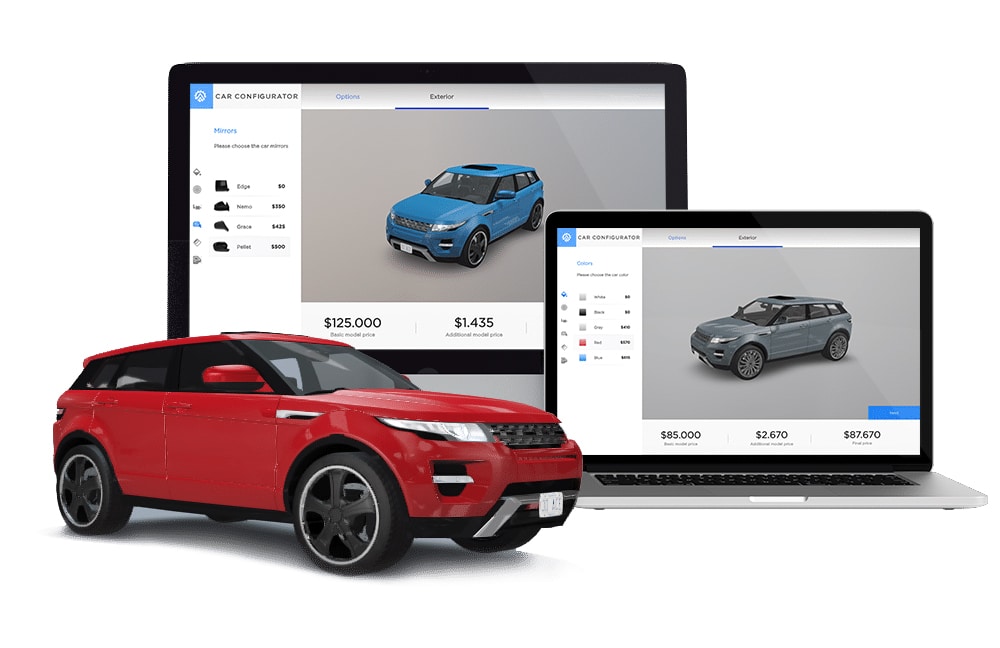
Program-Ace developed a configurator that takes your interactions with clients to a whole new level.
In parallel, UI/UX artists work on assets relating to an interface, and all assets are tailored and modified to render in the engine of choice correctly. The mechanics and logic of an application are handled by developers, ensuring that it runs smoothly and all functionality works. Finally, QA engineers review the completed product for bugs and other issues before unveiling it.
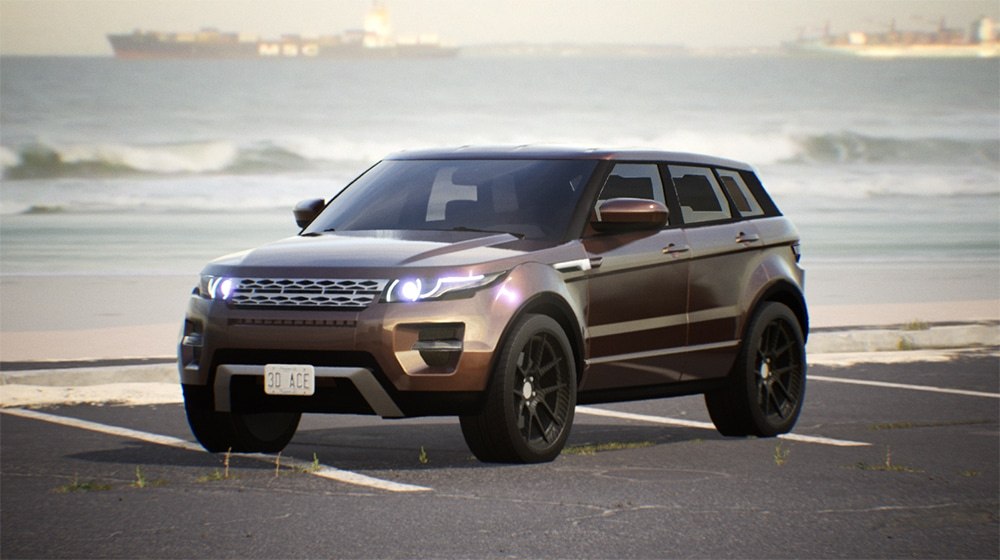
Car configurator developed by Program-Ace
Popular Car Configurator Platforms
Like all applications, car configurators are better suited to some platforms than others. Let’s examine the most common platforms where they are deployed.
Web platform
Web-based car configurators solutions bring unparalleled convenience and accessibility to car customization and purchasing. Users can interact with these platforms from any location as long as they have access to the internet. Integrating options for purchasing or preordering directly through the configurator allows for a streamlined experience that can often bypass the need to visit a physical dealership.
Compatibility with 2D rendering makes these web configurators particularly user-friendly, as 3D artists can create detailed car renders and upload them to the platform. Consequently, car enthusiasts can easily view high-quality images of various car models on various devices, from smartphones to desktop computers.
Enhancing the user experience further, the incorporation of a 3D car configurator on web platforms offers a more immersive and interactive approach to car customization. Users gain the ability to modify their car in real-time, experimenting with different colors, wheels, and interior options and seeing the effects of their choices instantly in a three-dimensional space. The best 3D car configurator provides a level of realism and detail that significantly enriches the virtual experience, closely mimicking the sensation of exploring a car in a showroom.
The sophistication and functionality of online car configurators simplify the process of tailoring a car to personal preferences and proceeding to purchase, all within a seamless digital environment. With the capacity to explore numerous configurations and smoothly transition to making a purchase, online car configurators are a transformative tool in today's automotive market, reshaping how consumers engage with car brands and make purchasing decisions.
Standalone platform
Standalone applications are defined by their ability to operate independently from external streams, relying instead on files or packages already installed on a device. Such applications span desktops, mobile devices, and gaming consoles, offering various utilities and functionalities. While the simplicity of 2D render approaches might not be the first choice for these types of applications, developers have various tools at their disposal, such as Windows Forms, WPF, and Qt, for instances where such an approach aligns with the project's requirements.
When considering the integration of a car configurator into standalone applications, the dynamic shifts towards more sophisticated development frameworks to accommodate the complex requirements of rendering 3D models. A 3D car configurator, for example, demands a robust platform capable of handling detailed graphics and user interactions in real time. The intricacies involved in creating a 3D car configurator require a careful blend of advanced programming skills and artistic design to ensure the final product offers a seamless and engaging user experience.
For those aiming to set a high standard in the automotive industry, the development of the best 3D car configurator within a standalone application can serve as a significant differentiator. Such a configurator would not only provide users with a highly realistic and interactive way to customize their vehicle but also push the boundaries of what can be achieved in software dedicated to car customization. By leveraging the full potential of standalone applications, companies can offer an immersive configurator experience directly from the user's device, enhancing overall engagement and satisfaction with the customization process.
XR platform
Several enterprises craft customization software designed explicitly for platforms that harness the power of Extended Reality (XR) technology, encompassing Augmented Reality (AR), Virtual Reality (VR), and Mixed Reality (MR). These advanced technologies provide users with an exceptionally immersive and interactive experience with automobiles, enhancing the sense of presence and engagement.
For instance, a VR headset can transport individuals into a virtual scenario where they find themselves standing adjacent to a 3D car, enabling them to perceive the vehicle in its actual size and grandeur. This virtual encounter allows for a comprehensive examination of the car's internal and external design, offering a profound understanding of its aesthetic and functional attributes.
Utilizing XR technologies in a car configurator sets the stage for a revolutionary way to explore and customize vehicles. Users can virtually step inside the car, experiencing the materials' texture, the seats' comfort, and the dashboard's layout as if they were physically present. The best 3D car configurator leverages these technologies to create a lifelike representation of the car, allowing for a range of customizations, from the color of the exterior to the choice of interior finishes, all experienced in a vivid, interactive environment.
Integrating XR technology into car configurators elevates the user experience to new heights and democratizes access to detailed vehicle exploration, transcending the limitations of physical proximity to a dealership. Ultimately, a 3D car configurator that incorporates AR, VR, or MR technologies becomes a powerful tool in the automotive industry, offering a cutting-edge platform for customers to interact with and personalize their future cars in a way that was once the realm of science fiction.
How to Create a Custom Car Configurator As Automotive Leaders Do
Leading automobile manufacturers worldwide have long recognized the importance of car configurators in their sales and marketing strategies. Understanding that customers require a deeper exploration of their products than static photos can offer, these industry giants have turned to sophisticated 3D car configurators to meet this demand. Such tools enable potential buyers to engage with the vehicle in a virtual environment, providing a comprehensive understanding of its features, design, and capabilities.
Among the array of 3D car configurators available, certain examples stand out for their remarkable ability to captivate customers. These configurators offer an immersive experience, allowing users to interact with a 3D model of the car. Users can rotate the model to view it from every angle, zoom in for close-up details, and customize various aspects of the vehicle, including color, wheels, and interior options, through a user-friendly interface.
The level of detail and realism in these configurators is exceptional, with photorealistic visuals that accurately represent the car's appearance under natural lighting conditions. The attention to detail ensures that customers can make informed decisions about their potential purchase by seeing a lifelike representation of how their customized car would look in the real world.
One of the best 3D car configurator experiences is designed to showcase the vehicle's aesthetic appeal and highlight its functional attributes. Customers can explore different configurations, adding or removing features to suit their lifestyle and preferences, and immediately see how these choices affect the car's final price.
Global automobile leaders' use of 3D car configurators exemplifies how digital innovation can enhance the customer journey. By offering a dynamic platform for vehicle customization and exploration, these configurators have set a new standard in the automotive industry, making it easier for customers to visualize their dream car in precise detail before making a purchase decision.
An impressive Audi Car Configurator
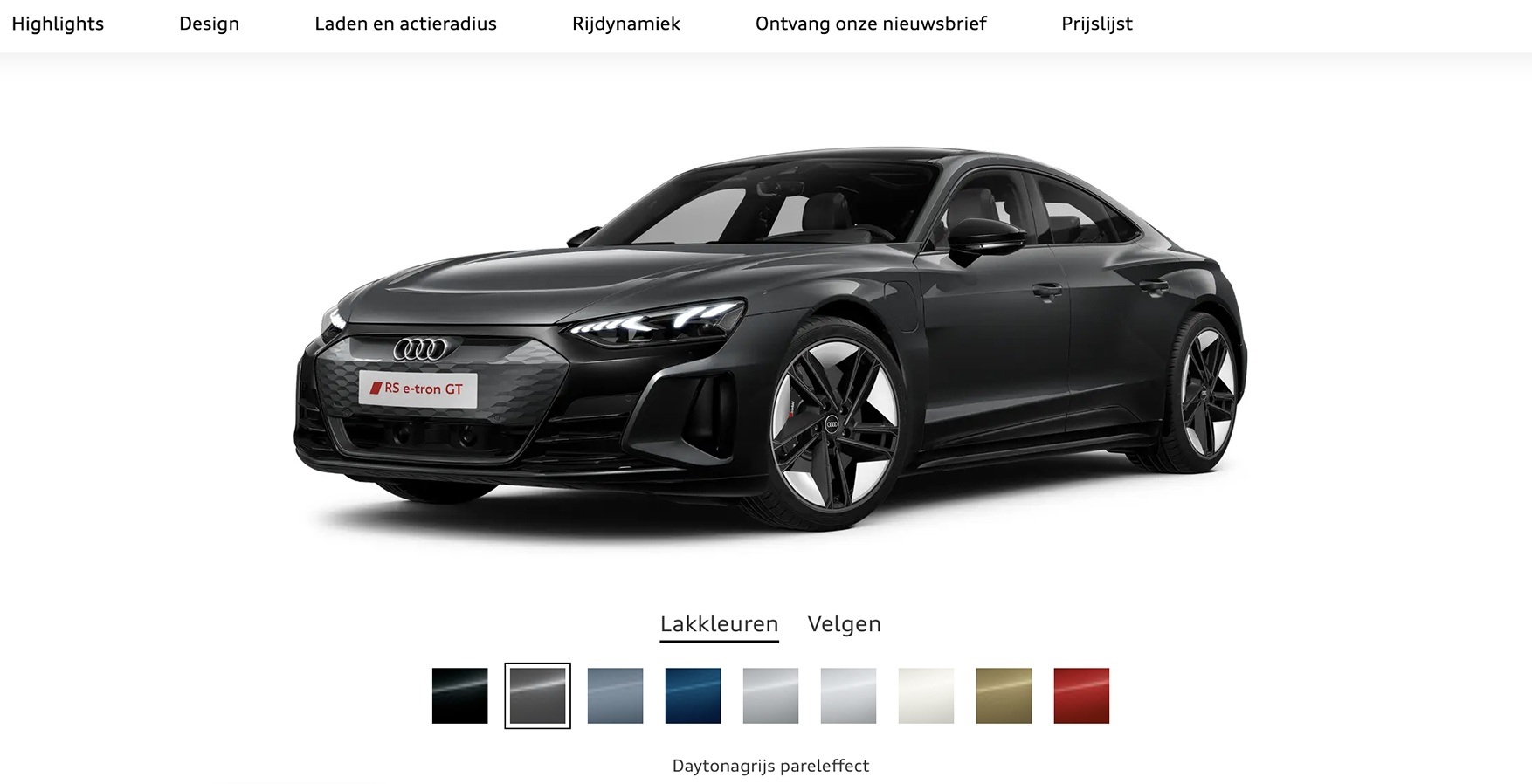
Audi, renowned for crafting luxury automobiles, excels not just in vehicle production but also in their digital presentation. The brand's website features a sophisticated car configurator tool, showcasing over 30 products. Each vehicle has a wealth of customization options, empowering clients to tailor their chosen model to their specifications and preferences.
Users who explore a model within the configurator are greeted with high-quality 2D renders of each car component. This detailed visualization allows them to meticulously select options that resonate with their style and needs, from the exterior design elements to the engine that powers the vehicle. The configurator's intuitive interface guides users through a seamless customization process, ensuring every aspect of the car reflects their individual tastes.
Adding a layer of immersion to the experience, the configurator can transform these photorealistic 2D renders into a fully interactive 3D model. This feature enables users to engage with the car virtually, rotating the model 360 degrees to examine it from every angle. Such an in-depth view comprehensively explains how each chosen element contributes to the car's overall aesthetics and functionality.
Customers appreciate the ability to configure an Audi that encapsulates all their desired attributes, from its appearance to its performance capabilities. The configurator also presents the final price, reflecting the cumulative cost of all customizations. This transparency ensures that users are well-informed about the investment required for their personalized luxury car. In digital automotive showcases, Audi's car configurator stands out, offering an unparalleled blend of choice, detail, and user engagement, making it a prime example of how the best 3D car configurator should function.
The complete BMW Car Configurator
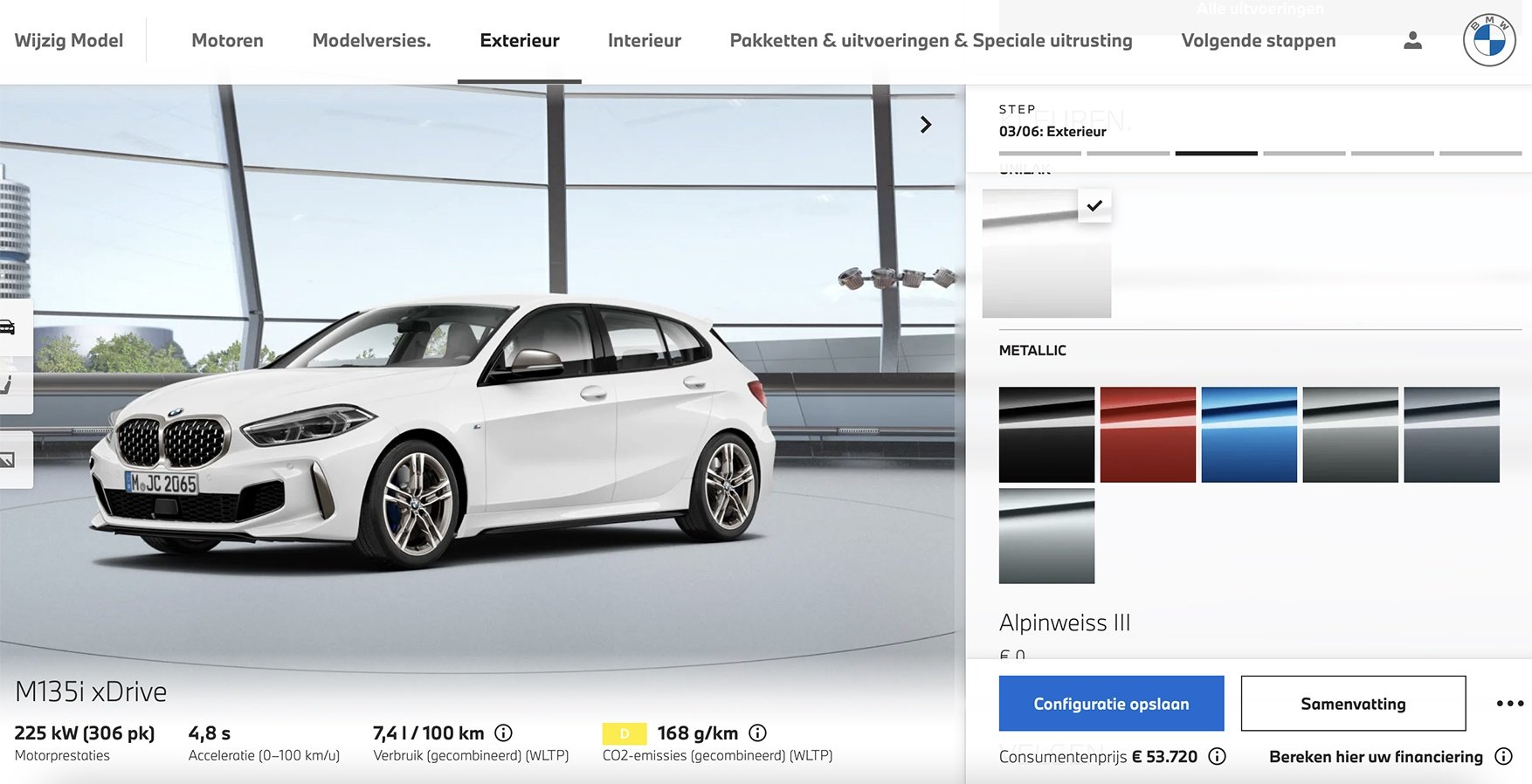
Upon engaging with the car configurator featured on BMW's website, users are immediately transported into a virtual experience reminiscent of visiting a high-end automobile showroom. The configurator presents a wide array of 92 vehicles, each available for detailed exploration. Clients can interact with 3D models of cars, rotating them through a full 360 degrees to examine every angle as if they were physically present in the showroom.
The level of customization offered by the configurator goes beyond mere visual exploration. Individuals looking to purchase have the unique ability to modify 3D automobile models in a live setting. Adjustments can be made to various elements, including paint finishes, color schemes, wheel designs, and more, enabling a highly personalized vehicle tailored to the buyer's preferences.
As selections are made, the configurator updates the final price in real time, accounting for each chosen feature. This transparent approach to pricing ensures that buyers are fully aware of the cost implications of their customizations. Finalizing their ideal car configuration, the next step for the buyer involves discussing the specifics and completing the purchase with a sales manager.
BMW's online configurator exemplifies the fusion of digital convenience with the tactile engagement of a showroom visit, setting a high standard for the automotive industry. It showcases how a well-crafted 3D car configurator can significantly enhance the car buying journey, offering an efficient and enjoyable way to customize and purchase a luxury vehicle.
Photorealistic Car Configurator by Program-Ace
Emulating the innovative strides of industry frontrunners, Program-Ace has developed an advanced real-time 3D car configurator, offering users a plethora of options to assess a vehicle thoroughly from every conceivable angle. The configurator allows clients to engage in an interactive exploration of a car, employing a highly intuitive interface that facilitates rotation, zooming, and the application of various custom features to tailor the vehicle to their personal tastes.
The configurator stands out for its photorealistic visuals, which are crafted to reflect the impact of natural lighting, ensuring that users can appreciate the true colors and details of the car. Such high-fidelity imagery allows for a clear and accurate representation of the vehicle, enhancing the decision-making process for potential buyers.
As users delve into customizing their cars, they can make adjustments to both exterior and interior elements in real-time, witnessing their modifications take shape instantaneously. Therefore, the dynamic process includes selecting from an array of paint finishes, wheel designs, and interior options, among other customizable features, all designed to align with the user's preferences.
Upon concluding their session with the configurator, customers are presented with a comprehensive summary that includes the final cost, incorporating all chosen customizations. Program-Ace's 3D car configurator exemplifies the pinnacle of digital innovation in automotive customization, making it a paradigm of how the best 3D car configurator should function, offering an unparalleled blend of user engagement, visual quality, and personalization.
Develop an Outstanding Car Configurator with Program-Ace
Building a custom car configurator can take time and some money from your budget. Still, it’s a crucial step to level up your customer service and boost sales. Often, automotive companies don’t have an in-house team of software developers and modelers to construct a custom configurator for each car model.
In this case, you can outsource a project to Program-Ace — an experienced software development service provider with deep expertise in building custom product configurators. Partnering with us, you’ll get a progressive presentation of your automobiles of any complexity, from a simple but sophisticated 3D configurator to a hyperrealistic and interactive AR/VR car model.
Let’s discuss your project in more detail — contact us for consultation and estimation to make a final decision.

